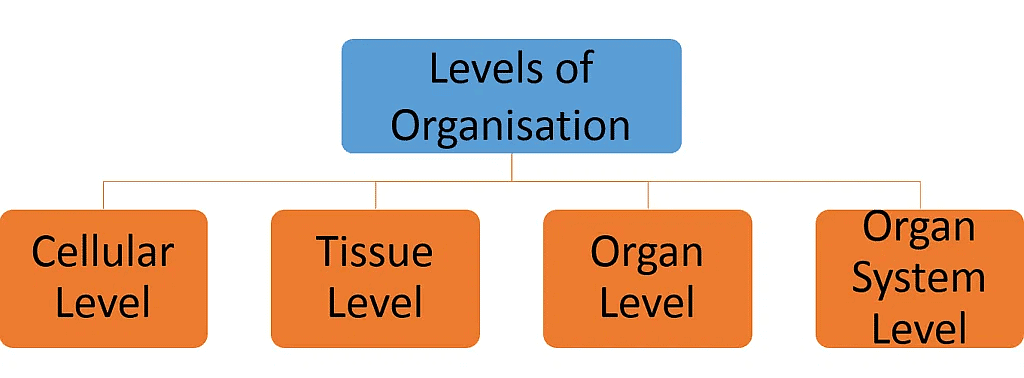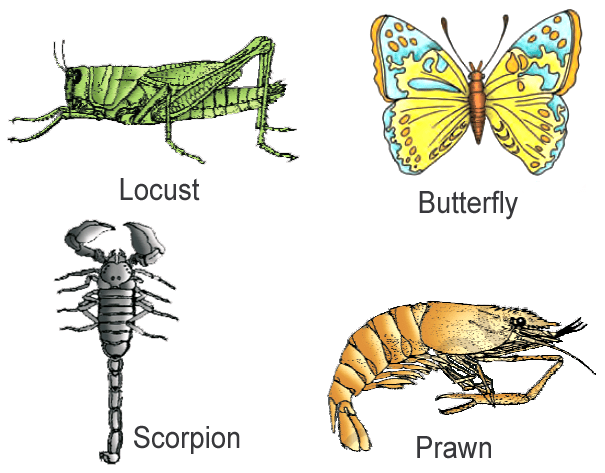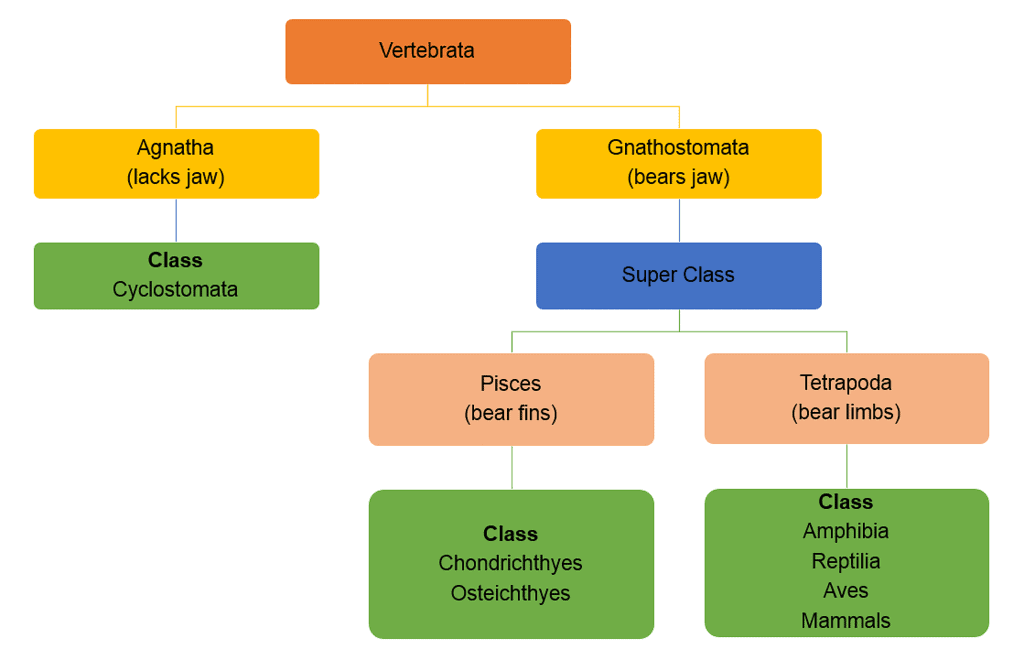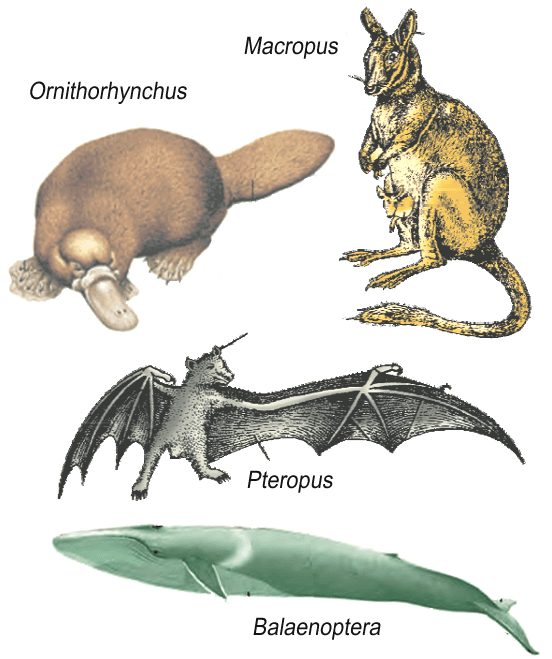Animal Kingdom Chapter Notes | Biology Class 11 - NEET PDF Download
The animal kingdom is one of the kingdoms among the Five-Kingdom Scheme of classification proposed by R.H. Whittaker.
What is the Basis of Classification of Animal Kingdom?
Animals are multicellular eukaryotes; do not possess a cell wall or chlorophyll like plants, and share the same mode of nutrition, that is, the heterotrophic mode.
- Besides these similarities, they are also related to their cell arrangement, body symmetry, the level of organization, coelom, presence/absence of notochord, etc.
- Based on these features, the animal kingdom has been classified into 11 different phyla. The different criteria for animal classification are explained below.
 Broad Classification of Animal Kingdom based on common fundamental features
Broad Classification of Animal Kingdom based on common fundamental features
1. Levels of Organization
Though animals are multicellular, the level of organization of cells varies from one animal to another. Here are the different levels of Organization:

- Cellular Level of Organization: The cells are loosely aggregated. An example of a Cellular Level of Organization is Sponges.
- Tissue Level of Organization: The cells that perform the same function are arranged into tissues. An example of Tissue Level of Organization is Coelenterates.
- Organ Level of Organization: The tissues are grouped to form organs. Each organ is specialized for a particular function. An example of an Organ Level of Organization is Platyhelminthes.
- Organ system Level of Organization: The organs associate to form some functional systems. In Annelids, Arthropods, Molluscs, Echinoderms, and Chordates, organs have associated to form functional systems, each system concerned with a specific physiological function. An example of an Organ System Level of Organization is the Circulatory System.
2. Patterns of Organ Systems
- Digestive System– There are two forms of digestive systems Complete and Incomplete Digestive system.
Incomplete Digestive System – This form of digestive system has one and only opening to the outside of the body, i.e., a solitary opening serving as both mouth and rear-end. Hence, the digestive system is incomplete.
Complete Digestive System – In this form there are two different openings to the outside of the body, a mouth and a rear-end or anus.
- Circulatory System –Circulatory framework might be of two sorts
Open Type – In open sort circulatory framework the blood is pumped out of the heart and all the cells and tissues are straightforwardly washed in it. Hence, the circulatory system is open.
Closed Type – In this kind of circulatory framework, the blood flows through a progression of vessels of varying size and diameters. These include the veins, arteries, and capillaries.
Question for Chapter Notes: Animal KingdomTry yourself:What is an open type circulatory system characterized by?View Solution
3. Body Symmetry
Symmetry is another basis for the classification of animals.

Generally, animals show two types of symmetry:
- Bilateral Symmetry: Those organisms falling under the bilateral body symmetry can be divided into two identical left and right halves through only one plane e.g. Annelids, Arthropods, Molluscs, etc.
 Bilateral symmetry
Bilateral symmetry
- Radial Symmetry: Those organisms falling under the radial body symmetry can be divided into two identical halves through any plane passing through the central axis. Examples are Coelenterates, ctenophores, and echinoderms.
 Radial symmetry
Radial symmetry
- Asymmetrical: Those organisms falling under the asymmetrical body symmetry cannot be divided into two halves through a median plane. An example of asymmetrical body symmetry is Sponges.
4. Diploblastic and Triploblastic Organization
All animals develop their tissues, organs and organ system from the cells that form the embryonic layers. Based on the number of embryonic layers, animals are classified into two: diploblastic and triploblastic animals.
- Diploblastic animals: In diploblastic animals, the cells form two embryonic layers, i.e., an outer layer- ectoderm and an inner layer – endoderm, e.g. Phylum Coelenterata. There is an undifferentiated layer called mesoglea between the ectoderm and endoderm.
- Triploblastic animals: In triploblastic animals, cells are arranged in three embryonic layers- ectoderm, endoderm and a middle layer – mesoderm.
Example: Animals belonging to Phyla Platyhelminthes to Chordata have a triploblastic organization.
5. Coelom
Coelom is a key feature for classification. Coelom is a cavity between the body wall and gut wall, lined by mesoderm. Depending on the presence/absence of coelom, animals have been classified into three:
- Coelomate: Coelom is present in a coelomate. Animals belonging to phyla Annelida, Mollusca, Arthropoda, Echinodermata, Hemichordata and Chordata are examples of coelomates.
- Pseudocoelomate: In some animals, the body cavity is not lined by mesoderm. Instead, the mesoderm is present as scattered pouches between the ectoderm and endoderm. Such a body cavity is called pseudocoelom. Animals possessing pseudocoelom are called pseudocoelomates. Examples of pseudocoelomates include Aschelminthes.
- Acoelomate: Coelom is absent in an acoelomate, the animals in which the body cavity is absent are called acoelomates e.g. Platyhelminthes.
6. Segmentation
Some animals have a body that is externally and internally divided into segments with a serial repetition of organs. This is called metameric segmentation, and the phenomenon is known as metamerism. An example of an animal with metamerism is the earthworm.
7. Notochord
- During embryonic development, some animals develop a mesodermally derived rod-like structure on their dorsal side, called a notochord.
- The animal kingdom has been broadly classified into two, based on the presence or absence of notochord- Non-Chordata and Chordata.

- Chordates possess notochord while non-chordates lack it. Animals belonging to the Phylum Porifera to Phylum Echinoderms are non-chordates.
Classification of the Kingdom Animalia
R.H. Whittaker organized organisms into five kingdoms. He classified organisms based on cell structure, mode, and source of nutrition and body design.
- The five kingdoms proposed by Whittaker are Monera, Protista, Fungi, Plantae, and Animalia.
- Kingdom Animalia constitutes all animals. Amongst the five kingdoms, the largest kingdom is the animal kingdom.
- Kingdom Animalia has been classified into 11 different phyla based on their body design or differentiation.

1. Phylum Porifera
Porifera means organisms with holes. They are commonly known as Sponges.

Sponge
Features of the poriferans are:
- Sponges are mostly asymmetrical in shape and primitive in terms of their cellular organization.
- They are multicellular animals with a cellular level of organization.
- Their bodies have a water transport system with a central cavity (spongocoel) that helps with food gathering, respiratory exchange, and waste removal.
- Water enters through small pores (ostia) in the body wall and exits through the osculum.
- Choanocytes or collar cells line the spongocoel and the canals.
- The body is supported by a skeleton made up of spicules or spongin fibres.
- Sponges are hermaphrodites, meaning they produce both eggs and sperm.
- They reproduce asexually by fragmentation and sexually by forming gametes.
- Fertilisation is internal.
- They have an indirect development with a larval stage that is morphologically distinct from the adult.
Examples: Sycon (Scypha), Spongilla (Freshwater sponge), Euspongia (Bath sponge)

2. Phylum Coelenterata (Cnidaria)
The term Coelenterata is derived from the Greek word “kilos” which means hollow-bellied.
 Cnidaria
Cnidaria
Their features are:
- Cnidarians are aquatic animals, mostly found in the marine environment.
- They are radially symmetrical animals that can be sessile (attach themselves) or free-swimming.
- The name 'cnidaria' comes from their stinging cells or cnidoblasts that contain nematocysts. These are used for defence, anchorage and capturing prey.

Diagrammatic view of
Cnidoblast
- Cnidarians have a tissue level of organisation and are diploblastic.
- They have a central gastro-vascular cavity with a single opening, the mouth on hypostome.
- Digestion is both extracellular and intracellular.
- Some cnidarians, such as corals, have a calcium carbonate skeleton.
- Cnidarians exhibit two main body forms: polyp and medusa.
- Polyps are cylindrical and sessile, while medusae are umbrella-shaped and free-swimming.
- Some cnidarians alternate between these two forms in a process called alternation of generation (Metagenesis).
- Polyps produce medusae asexually, while medusae form the polyps sexually.
Examples: Physalia (Portuguese man-of-war), Adamsia (Sea anemone), Pennatula (Sea-pen), Gorgonia (Sea-fan), Meandrina (Brain coral)

Examples of Coelenterata indicating outline of their body form :
(a) Aurelia (Medusa) (b) Adamsia (Polyp)
3. Phylum Ctenophora
- Ctenophores, commonly known as sea walnuts or comb jellies, are exclusively marine creatures that have radial symmetry and a tissue level of organization.
- Ctenophores have a radially symmetrical body.
- They are diploblastic, which means their body has two layers of tissues.
- The body has eight external rows of ciliated comb plates that aid in movement.
- They exhibit bioluminescence, which is the ability to emit light.
- Ctenophores carry out both extracellular and intracellular digestion.
- Ctenophores have sexes that are not separate.
- Reproduction takes place only through sexual means.
- Fertilisation is external with indirect development.
Example: Pleurobrachia (Ctenophora)
 Example of Ctenophora (Pleurobrachia)
Example of Ctenophora (Pleurobrachia)
4. Phylum Platyhelminthes
Platyhelminthes are commonly known as flatworms.
 Flatworm
Flatworm
Flatworms are a type of animal that have a flattened body, giving them their name. They are mostly found as endoparasites in animals, including humans.
Their features are:
- Dorsoventrally flattened body.
- Bilaterally symmetrical, triploblastic and acoelomate.
- Hooks and suckers are present in the parasitic forms
- Some absorb nutrients directly through their body surface
- Specialised cells called flame cells help in osmoregulation and excretion
- Sexes are not separate, and fertilisation is internal
- Development is through many larval stages
- Some members, like Planaria, have a high regeneration capacity
- Examples of phylum Platyhelminthes include -Taenia (tapeworm) and Fasciola (liver fluke)

5. Phylum Aschelminthes
Phylum Aschelminthes include roundworms. The body of roundworms is circular in cross-section, which is why they are called roundworms.

Their features are :
- Roundworms may be free living, aquatic and terrestrial or parasitic in plants and animals.
- Roundworms have organ-system level of body organisation.
- They are bilaterally symmetrical, triploblastic and pseudocoelomate animals.
- The alimentary canal of roundworms is complete, and they have a well-developed muscular pharynx.
- An excretory tube removes body wastes from the body cavity through the excretory pore.
- Roundworms have separate sexes (dioecious), meaning males and females are distinct.
- Often, females are longer than males.
- Fertilisation is internal, and development may be direct (the young ones resemble the adult) or indirect.
- Examples of roundworms include Ascaris (Roundworm), Wuchereria (Filaria worm), and Ancylostoma (Hookworm).
6. Phylum Annelida
Annelids are commonly known as segmented or ringed worms. Annelids can be aquatic (marine and freshwater) or terrestrial, free-living, and sometimes parasitic.
 Earthworm (land)
Earthworm (land)
They have the following features:
- They exhibit organ-system level of body organisation and bilateral symmetry.
- Annelids are triploblastic, metamerically segmented, and coelomate animals.
- Their body surface is distinctly marked out into segments or metameres, which is why they are called Annelids.
- Annelids possess longitudinal and circular muscles which help in locomotion.
- Aquatic annelids like Nereis possess lateral appendages, parapodia, which help in swimming.
- Annelids have a closed circulatory system.
- Nephridia (sing. nephridium) help in osmoregulation and excretion.
- Neural system consists of paired ganglia (sing. ganglion) connected by lateral nerves to a double ventral nerve cord.
- Annelids have various methods of reproduction, such as sexual reproduction.
Examples of Annelids include Nereis, Pheretima (Earthworm), and Hirudinaria (Bloodsucking leech).
 Examples of Annelida : (a) Nereis (b) Hirudinaria
Examples of Annelida : (a) Nereis (b) Hirudinaria
7. Phylum Arthropoda
Arthropod means jointed legs. Animals which have jointed appendages belong to this phylum
Arthropods are the largest phylum of the animal kingdom which includes insects. More than two-thirds of all the known species on earth are arthropods.
Other features are:
- They have an organ-system level of organisation.
- They are bilaterally symmetrical, triploblastic, segmented, and coelomate animals.
- Their body is covered with a chitinous exoskeleton, and they are composed of three parts: head, thorax, and abdomen.
- Arthropods have jointed appendages, which include legs, antennae, and mouthparts. The term "arthros" means joint, and "poda" means appendages.
- They have respiratory organs such as gills, book gills, book lungs, or tracheal system. The circulatory system is of the open type.
- Sensory organs like antennae, compound and simple eyes, statocysts, or balancing organs are present.
- Excretion takes place through malpighian tubules. They are mostly dioecious, and fertilisation is usually internal. They are mostly oviparous.
- Arthropods include economically important insects like Apis (Honey bee), Bombyx (Silkworm), and Laccifer (Lac insect). They also include vectors such as Anopheles, Culex, and Aedes (Mosquitoes), gregarious pest like Locusta (Locust) and living fossils like Limulus (King crab).

8. Phylum Mollusca
Phylum Mollusca consists of a large group of animals. Features are:
- Molluscs are animals that belong to the second largest animal phylum. They can be found in aquatic and terrestrial habitats and possess an organ-system level of organisation.
- Molluscs are bilaterally symmetrical, triploblastic and coelomate animals.
- Their body is unsegmented and covered by a calcareous shell.
- They have a distinct head, muscular foot and visceral hump.
- The mantle, a soft and spongy layer of skin, covers the visceral hump. The space between the mantle and the hump is known as the mantle cavity, which contains feather-like gills.
- The anterior head region has sensory tentacles and the mouth has a radula, a file-like rasping organ used for feeding.
- Molluscs have respiratory and excretory functions.
- Molluscs are usually dioecious and oviparous with indirect development.
 Pearly Nautilus
Pearly Nautilus
Examples of molluscs are Pila (Apple snail), Pinctada (Pearl oyster), Sepia (Cuttlefish), Loligo (Squid), Octopus (Devil fish), Aplysia (Seahare), Dentalium (Tusk shell) and Chaetopleura (Chiton).

9. Phylum Echinodermata
The term Echinodermata is derived from the Greek words, echinos meaning hedgehog and derma meaning skin. Thus, echinoderms are spiny-skinned animals.
 Echinodermata: Starfish
Echinodermata: Starfish
- These are spiny bodied marine animals with a complete digestive system, a water vascular system and a lack of excretory system.
- They have an endoskeleton of calcareous ossicles and exhibit organ-system level of organisation.
- Adult echinoderms are radially symmetrical, but their larvae are bilaterally symmetrical.
- They are triploblastic and coelomate animals.
- The mouth is on the lower (ventral) side, and the anus is on the upper (dorsal) side.
- The presence of a water vascular system is the most distinctive feature of echinoderms. It helps in locomotion, capture and transport of food, and respiration.
- They don’t have an excretory system.
- Echinoderms have separate sexes and reproduce sexually. Fertilisation is usually external, and development is indirect with free-swimming larva.
- Echinoderms include species such as Asterias (Star fish), Echinus (Sea urchin), Antedon (Sea lily), Cucumaria (Sea cucumber) and Ophiura (Brittle star).

10. Phylum Hemichordata
Hemichordata was previously considered a sub-phylum of Chordata but is now a separate phylum under non-chordata.
 Balanoglossus: Body organisation of Hemichordata
Balanoglossus: Body organisation of Hemichordata
The characteristics of phylum Hemichordata are as follows:
- Hemichordates are bilaterally symmetrical, triploblastic, and coelomate animals with organ-system level of organisation.
- The body is cylindrical and composed of an anterior proboscis, a collar, and a long trunk.
- Hemichordates have a rudimentary structure in the collar region called the stomochord, which is similar to the notochord found in chordates.
- Hemichordates have an open circulatory system and respire through gills.
- The proboscis gland is their excretory organ.
- They are dioecious, which means the sexes are separate and fertilisation is external. Their development is indirect.
Examples of hemichordates include Balanoglossus and Saccoglossus.
11. Phylum Chordata

The Chordates possess the following characteristics:
- They are bilaterally symmetrical, triploblastic with an organ-system level of classification.
- They possess a notochord and a nerve cord.
- Possess a post-anal tail.
- The circulatory system is closed type.
Phylum Chordata can be divided into the following sub-phyla:
 A. Urochordata
A. Urochordata
- They are also known as protochordates.
- The adults are fixed to the substratum.
- It is also known as Tunicate because the body of an adult is enclosed within a tunic made up of cellulose-like substance known as tunicin.
- Notochord can be seen only in the larval stage and disappears in adults.
- The nerve cord present in larva is replaced by a dorsal ganglion in adults.
- The larva can move and undergoes a metamorphosis.
- For e.g., Ascidia, Salpa, Doliolum
B. Cephalochordata

- They are also known as protochordates.
- The atrium is present.
- Motile adult and larval stage.
- The tail is present throughout life.
- They show progressive metamorphosis.
- The notochord is found throughout life. Numerous well-developed pharyngeal gill slits are present.
- For e.g., Lancelets possess the notochord and nerve cord throughout their life. However, they lack the brain and bony vertebral column like Branchiostoma.
C. Vertebrata
The characteristic features of vertebrates include:
- These are advanced chordates and have cranium around the brain.
- The notochord is replaced by a vertebral column in adults.
- This is why it is said that ‘all vertebrates are chordates but all chordates are not vertebrates’.
- A high degree of cephalization is observed.
- The epidermis is multi-layered.
- They consist of three types of muscles-striped, unstriped and cardiac.
- They have a well-developed coelom.
- The alimentary canal is complete.
- The heart is three or four-chambered.
- They have well-developed respiratory and excretory systems.
- Endocrine glands are present in all.
- They are unisexual and reproduce sexually, hagfish being an exception.
- For e.g., humans.
Classification of Vertebrates into Classes:

(i) Class - Cyclostomata

Their features are:
- All living members of the class Cyclostomata are ectoparasites on some fishes
- Cyclostomes have an elongated body with 6-15 pairs of gill slits for respiration
- They have a sucking and circular mouth without jaws
- Their body is devoid of scales and paired fins
- Cranium and vertebral column are cartilaginous
- Circulation is of closed type
- Cyclostomes are marine but migrate to freshwater for spawning
- After spawning, they die within a few days
- Their larvae return to the ocean after metamorphosis
Examples: Petromyzon (Lamprey), Myxine (Hagfish)

Their features are:
- Marine animals with a streamlined body and a cartilaginous endoskeleton.
- Mouth located ventrally.
- Persistent notochord throughout life.
- Separate gill slits without operculum (gill cover).
- Tough skin with minute placoid scales.
- Powerful jaws with teeth-modified placoid scales which are backwardly directed.
- Predaceous animals that must swim constantly to avoid sinking due to the absence of an air bladder.
- Two-chambered heart (one auricle and one ventricle).
- Some have electric organs (e.g., Torpedo) and some possess poison sting (e.g., Trygon).
- Cold-blooded (poikilothermic) animals that lack the capacity to regulate their body temperature.
- Sexes are separate.
- In males, pelvic fins bear claspers.
- They have internal fertilisation, and many of them are viviparous.
Examples: Scoliodon (Dog fish), Pristis (Saw fish), Carcharodon (Great white shark), Trygon (Sting ray)
Bony fishes are found in both marine and freshwater habitats. They have a streamlined body and a bony endoskeleton.
 Fishes of class Osteichthyes
Fishes of class Osteichthyes
Here are some of their characteristics:
- Mouth is mostly terminal.
- They have four pairs of gills, which are covered by an operculum on each side.
- Skin is covered with cycloid/ctenoid scales.
- Air bladder is present, which regulates buoyancy.
- Heart is two-chambered (one auricle and one ventricle).
- They are cold-blooded animals.
- Sexes are separate.
- Fertilisation is usually external.
- They are mostly oviparous, and development is direct.
- Bony fishes can be found in various habitats.
Here are some examples:
- Marine: Exocoetus (Flying fish), Hippocampus (Sea horse).
- Freshwater: Labeo (Rohu), Catla (Katla), Clarias (Magur).
- Aquarium: Betta (Fighting fish), Pterophyllum (Angel fish).
Amphibians can live in both aquatic and terrestrial habitats, and their name reflects this dual life. They mostly have two pairs of limbs and a head and trunk. Some may have a tail.
 Animals in class Amphibia
Animals in class Amphibia
Here are some of their characteristics:
- Their skin is moist and lacks scales.
- They have eyelids, a tympanum for hearing, and a cloaca, where the digestive, urinary, and reproductive tracts open to the exterior.
- Respiration is through gills, lungs, and the skin.
- Amphibians have a three-chambered heart (two auricles and one ventricle) and are cold-blooded animals.
- Fertilisation is external and they are oviparous, with indirect development.
- Some common examples of amphibians include Toads (Bufo), Frogs (Rana), Tree Frogs (Hyla), Salamanders (Salamandra), and Limbless Amphibians (Ichthyophis).
Reptiles are animals that move in a creeping or crawling manner. They are primarily terrestrial creatures.

Reptiles: (a) Chameleon (b) Crocodilus (c) Chelone (d) Naja
Here are some of their characteristics :-
- Covered by dry, cornified skin, epidermal scales or scutes
- Do not have external ear openings
- Limbs are present in two pairs, when present
- Heart is usually three-chambered, except for crocodiles
- Reptiles are poikilothermic
- Shed their scales as skin cast
- Sexes are separate
- Fertilisation is internal
- They are oviparous and development is direct
Examples:
- Turtle: Chelone
- Tortoise: Testudo
- Tree lizard: Chameleon
- Garden lizard: Calotes
- Crocodile: Crocodilus
- Alligator: Alligator
- Wall lizard: Hemidactylus
- Poisonous snakes: Naja (Cobra), Bangarus (Krait), Vipera (Viper)
(vi) Class - Aves
Their characteristics include:
- Presence of feathers, and most of them can fly except flightless birds (e.g., Ostrich).
- Possess beak, and the forelimbs are modified into wings.
- Hind limbs generally have scales and are modified for walking, swimming or clasping the tree branches.
- Skin is dry without glands except the oil gland at the base of the tail
- Endoskeleton is fully ossified (bony), and the long bones are hollow with air cavities (pneumatic)
- Digestive tract has additional chambers, the crop and gizzard
- Heart is completely four-chambered
- Warm-blooded (homoiothermous) animals, able to maintain a constant body temperature
- Respiration is by lungs, and air sacs connected to lungs supplement respiration
- Sexes are separate, and fertilisation is internal
- Oviparous and development is direct
Examples of Birds (Aves) are:
- Corvus (Crow)
- Columba (Pigeon)
- Psittacula (Parrot)
- Struthio (Ostrich)
- Pavo (Peacock)
- Aptenodytes (Penguin)
- Neophron (Vulture)



Their characteristics include :-
- Mammals can be found in various habitats, such as: Polar ice caps, Deserts, Mountains, Forests, Grasslands, Dark caves and some mammals have adapted to living in water or flying.
- Mammals possess unique features that differentiate them from other animals. These features include:
(i) Milk-producing glands (mammary glands) to nourish their young
(ii) Two pairs of limbs for movement
(iii) Skin covered in hair
(iv) External ears or pinnae
(v) Different types of teeth
(vi) A four-chambered heart
(vii) Homoiothermy (the ability to maintain a constant body temperature)
(viii) Respiration by lungs
(ix) Separate sexes and internal fertilisation
(x) Mammals have diverse methods of reproduction. Some are oviparous (lay eggs) while others are viviparous (give birth to live young). - Some examples of viviparous mammals include: Macropus (Kangaroo), Pteropus (Flying fox), Camelus (Camel), Macaca (Monkey), Rattus (Rat), Canis (Dog), Felis (Cat), Elephas (Elephant), Equus (Horse), Delphinus (Common dolphin), Balaenoptera (Blue whale), Panthera tigris (Tiger), Panthera leo (Lion).
Summary

|
180 videos|362 docs|148 tests
|
FAQs on Animal Kingdom Chapter Notes - Biology Class 11 - NEET
| 1. What are the main levels of organization in the animal kingdom? |  |
| 2. How does body symmetry play a role in classifying animals? |  |
| 3. What is the difference between diploblastic and triploblastic organisms? |  |
| 4. What is coelom and why is it important in animal classification? |  |
| 5. What role does segmentation play in the classification of animals? |  |
























